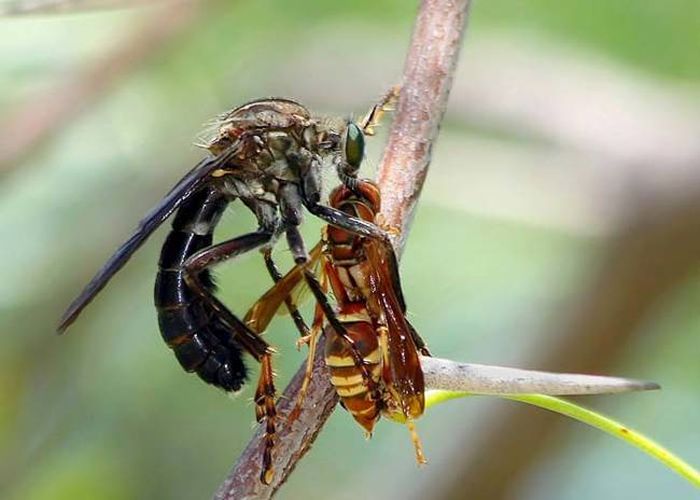|
|
Asilidae, Assassin Robber Fly
|
Biology
The Asilidae are predators, both in the juvenile stage and the adult stage, and feed on small arthropods, mainly insects. Although predatory forms in the adult stage are present in other taxonomic groups of Diptera the Asilidae are the most representative for the number of species and for uniformity of feeding behavior. They are aggressive to the point of earning the common name, in English, of "robber flies". The combination of high biodiversity and high predatory activity leads to this family playing an important role in the ecological stability of entomofauna.
The life cycle takes place in 1–3 years. The postembryonic development consists of four larval stages (instars) and one pupa. The larvae of the first instar differ from other stages in both ethology and trophic regime. The larvae of most known asilids live in the soil or in the case of some taxonomic groups, in rotting organic material, usually wood and the bark of dead trees. With regard to feeding behavior, most of the literature gives the larvae of the Asilidae as entomophagous, but there are also doubts about the real nature of the trophic regime and its mechanisms. The entomophagy of some species had indeed been already hypothesized by some authors of the ' nineteenth century, based on the findings of larvae of asilids associated with larvae of other insects, but Melin (1923) asserted that in reality predation was occasional and secondary to the plant-based diet. More recent studies have confirmed the entomophagy of some asilids without extending this species feeding behavior for the whole family. Less certain, however, is the mechanism of implementing entomophagy: in general, the behavior is cited as predation, but for some species may be ectoparasitoids . Musso (1983) described the feeding behavior of the larvae of Machimus rusticus and its evolution during postembryonic development : in particular, the larvae of the first instar does not feed on insects, those of the second instar feed on secretions by larvae of beetles (and may cause death), while the larvae of the third and fourth instars actually behave like predators. In short, the feeding behavior of larval asilids can configure as intermediate between predation and ectoparasitism.
Much better known and described in detail is the behavior of adults. In general, the activity of predation of adults is concentrated in the hottest hours in open, sunny spaces, while at night they take refuge in the dense vegetation. The Asilidae are excellent flyers and, in most of the family, they capture prey in flight; other behaviors,are found, however and Asilidae are often seen stationed to ambush prey at strategic points. This behavior signifies that the sight plays an essential role in the detection of prey and their capture. The prey is caught with the tarsi and immobilized as a result of the paralysis caused by the injection of saliva. The asilid pierces the integument of the prey with the prepharyx (hyopharynx) in preferential points of least resistance as the eyes, the membranous area of transition between the head and thorax (neck) or between thorax and abdomen, or between the last urotergiti. Puncture is followed by the injection of saliva, whose active components perform two functions: the neurotoxins cause paralysis of the victim, while proteolytic enzymes lead to the breakup and liquefaction of internal tissues, in a short time the predator is able to feed sucking the internal fluids through the alimentary canal.
|
|









